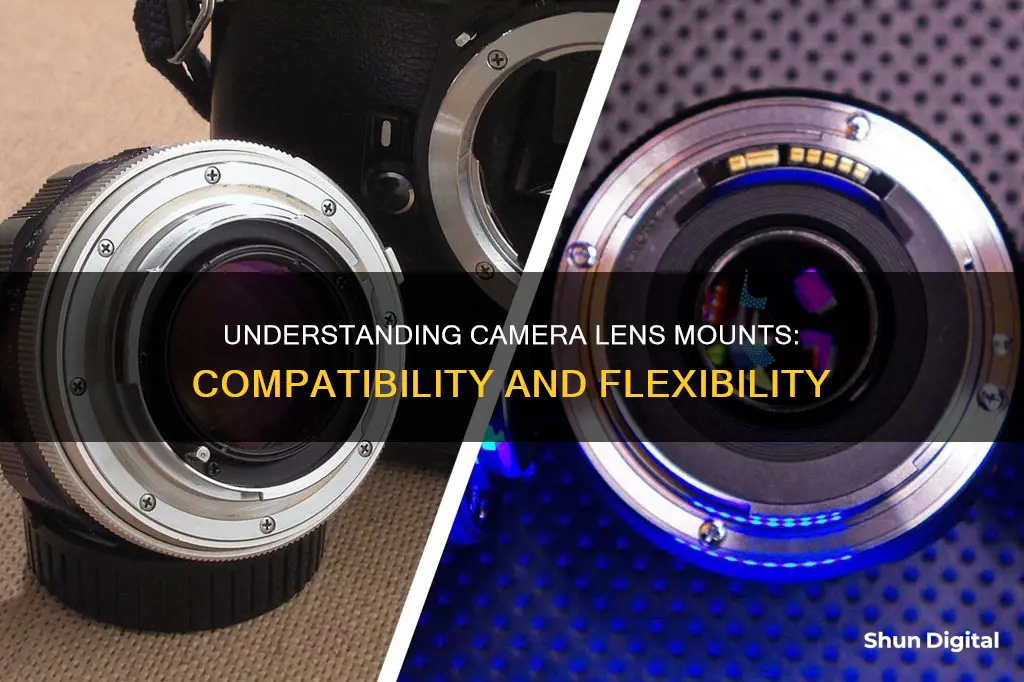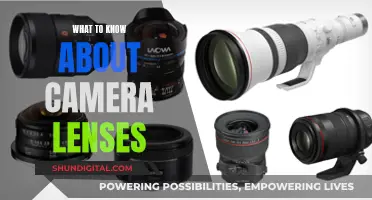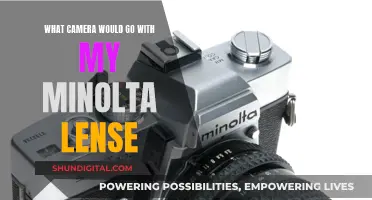
A lens mount is the junction where a camera body and a lens meet. It is a feature of camera systems where the body allows interchangeable lenses. Lens mounts are mechanical and sometimes electrical interfaces between a camera and a lens. They are usually bayonet-type, screw-threaded, or breech-lock (friction lock). Each camera manufacturer has its own proprietary mount, so it is important to know which lens mount your camera has before buying a lens.
What You'll Learn

Lens mounts: types and compatibility
A lens mount is an interface between a camera body and a lens. It is a feature of camera systems where the body allows interchangeable lenses. Lens mounts are also used to connect optical components in instrumentation that may not involve a camera.
Lens mounts can be screw-threaded, bayonet-type, or breech-lock (friction lock). Modern still camera lens mounts are of the bayonet type, as this mechanism precisely aligns the mechanical and electrical features between the lens and body. Screw-threaded mounts are fragile and do not align the lens in a reliable rotational position, but they are still used for video cameras and optical instrumentation.
Bayonet mounts have tabs around the base of the lens that fit into recesses in the lens mounting plate on the camera. The tabs are often "keyed" to ensure the lens is inserted in only one orientation. Once inserted, the lens is turned a small amount and locked in place with a spring-loaded pin.
Lens mounts of competing manufacturers (such as Sony, Nikon, and Canon) are almost always incompatible. In addition to the mechanical and electrical interface variations, the flange focal distance from the lens mount to the film or sensor can also differ.
In movie cameras, the two most popular mounts in current usage on professional digital cinematography cameras are Arri's PL-mount and Panavision's PV-mount. The PL-Mount is used on Arri and RED digital cinematography cameras, which, as of 2012, were the most used cameras for films shot in digital. The Panavision mounts are exclusively used with Panavision lenses and are only available on Panaflex cameras or third-party cameras "Panavised" by a Panavision rental house.
- Canon EF
- Canon RF
- Fujifilm X
- Fujifilm G
- Leica L
- Leica M
- Nikon F
- Nikon Z
- Pentax K
- Sony E
Why Are Camera Lenses So Affordable?
You may want to see also

Camera lens mount identification
A lens mount is the interface between a camera body and a lens. It is a feature of camera systems where the body allows for interchangeable lenses. The lens mount is an opening of a specific size that allows for attaching lenses designed for that mount.
Types of Lens Mounts
There are three types of lens attachment systems: screw-threaded, bayonet, and breech-lock (friction lock). Modern still camera lens mounts are of the bayonet type, as bayonet mounts allow for a tight and precise fit, which is especially important when shooting with modern high-resolution cameras.
Identifying a Lens Mount
To identify a lens mount, you can refer to the camera's manual, which should contain information about the mount and a list of compatible lenses. Another option is to look up the lens mounted on your camera, as its description should contain the name of the mount.
Examples of Lens Mounts
- Nikon AI Mount: Look for the 'Rabbit Ears' at the top. An AI lens will have small cutouts so that more light can fall on the smaller aperture lettering. A non-AI lens almost always has solid rabbit ears.
- Canon FD Mount: The entire silver ring rotates to attach the lens while the body and glass of the lens remain stationary.
- M42 Screw Mount: This mount screws onto the camera and is easy to identify due to the presence of a screw thread.
- Pentax K Bayonet Mount: Visually, there are three bayonet mounting points, and on the side of the lens, there will be a yellow or white plastic dot.
- Minolta MD and AF Mounts: The manual focus MD lenses are all metal and have an aperture ring. The later autofocus AF lenses are made of plastic or coated metal and have no aperture controls on the base of the lens.
- Olympus OM Mount: Any OM mount lens will have two rectangular, spring-loaded buttons directly opposite each other, making visual identification easy.
- Leica M39 Mount: This mount is smaller than the Leica M42 mount and has no aperture pin as all the lenses are preset.
- Praktica Bayonet Mount: These are fairly common and easy to identify due to their three round electronic contacts in a row and dark grey plastic body.
Disposing of Old Camera Lenses: A Step-by-Step Guide
You may want to see also

Lens mount adapters
A lens mount adapter allows you to attach a lens from one camera mount to a camera with a different mount. This means you can use an otherwise incompatible lens with your camera.
Adapters are especially useful for those who want to use their old SLR lenses on a new mirrorless camera body. For example, you can use a mount adapter to attach Canon EF lenses to Canon R camera bodies, or Nikon F mount lenses to Nikon Z camera bodies.
Adapters can be purchased from a variety of manufacturers, including Canon, Nikon, and third-party companies. Some manufacturers provide lens mount adapters with full compatibility and autofocus features, but most adapters are "dumb" and cannot transmit electronic data.
When using a lens mount adapter, you will need to put all settings on your lens and camera into manual mode, as a lens adapter doesn't enable electronic communication between the lens and camera. You will need to manually set your exposure and focus.
To find the right lens adapter for your lens and camera, you should first identify your lens mount and your camera mount. You can do this by searching for the camera model followed by the lens mount.
Camera Contact Lenses: Fact or Fiction?
You may want to see also

DSLR vs mirrorless camera lens mounts
When it comes to DSLR vs mirrorless camera lens mounts, there are several factors to consider. Here are some key differences and similarities between the two types of camera lens mounts:
Lens Selection:
DSLR cameras have been on the market for a longer period, resulting in a broader selection of lenses to choose from. This includes a wider range of specialty lenses such as super telephoto and tilt-shift lenses. Additionally, DSLR lenses are often more affordable due to the maturity of the system. However, mirrorless camera lens options are rapidly expanding, and manufacturers are actively investing in developing new lenses for mirrorless systems.
Lens Mount Compatibility:
DSLR lenses can be adapted to work with mirrorless camera bodies using lens adapters. However, it's important to note that using an adapter may affect certain features, such as autofocus speed and image stabilisation. Native mirrorless lenses are designed specifically for mirrorless camera mounts and can offer improved performance and compatibility.
Lens Size and Weight:
Mirrorless camera lenses tend to be more compact and lightweight compared to DSLR lenses. This is due to the shorter flange distance in mirrorless cameras, which allows for a more streamlined design. However, it's worth noting that some mirrorless lenses, especially those designed for full-frame sensors, can be similar in size and weight to their DSLR counterparts.
Lens Performance:
Both DSLR and mirrorless lenses can deliver exceptional image quality. The performance depends on various factors, including the sensor size, autofocus system, and lens design. In terms of autofocus, mirrorless cameras have made significant advancements and often offer faster and more accurate focusing capabilities. However, DSLR lenses still excel in certain scenarios, such as autofocusing on fast-moving targets, which is crucial for sports or wildlife photography.
Lens Innovations:
Mirrorless camera systems are witnessing more frequent innovations and updates. Manufacturers are actively investing in research and development for mirrorless lenses, introducing advanced features such as larger lens mounts and improved optical designs. This continuous innovation ensures that mirrorless lenses stay at the forefront of technology.
In summary, while DSLR lenses offer a broader selection and more affordable options, mirrorless lenses provide the advantage of compactness and frequent innovations. The choice between DSLR and mirrorless lens mounts depends on your specific needs, budget, and the features that are most important to you.
Claiming Camera Equipment on Taxes: A Comprehensive Guide
You may want to see also

Sensor size and its impact on lens options
When it comes to photography, sensor size is an important factor that can influence the lens options available to you. Different camera systems offer various sensor sizes, and understanding the impact of sensor size on lens choices will help you make informed decisions about your photography equipment.
Firstly, it's crucial to understand the concept of a "crop factor." The crop factor is the ratio of the sensor's diagonal size compared to a full-frame 35mm sensor. This value indicates how much of the image is cropped when using a 35mm lens due to the sensor's limited size. A higher crop factor means that the sensor crops out more of the image's periphery, resulting in a narrower field of view. This has implications for lens selection, as a smaller sensor may require a wider lens to achieve the same field of view as a larger sensor.
The size of the sensor also affects the depth of field. As the sensor size increases, the depth of field decreases for a given aperture setting when framing a subject of the same size and distance. This means that larger sensors require the use of smaller aperture sizes to maintain the same depth of field. This is particularly relevant for portrait photography, where a shallow depth of field is often desired to create background blur.
Additionally, the sensor size impacts the weight and cost of lenses. Smaller sensors typically require lighter lenses for the same angle of view, zoom range, build quality, and aperture range. This is an important consideration for travel, wildlife, and hiking photography, where carrying bulky equipment can be a burden. However, heavier lenses for larger sensors tend to be more expensive.
The sensor size also influences the availability of certain lens types. Some lenses, such as tilt-shift lenses, are designed specifically for certain sensor sizes. Additionally, fast ultra-wide-angle lenses (f/2.8 or larger) are less common for cropped sensors, which may be a limiting factor for sports or photojournalism photography.
Lastly, the sensor size can affect the low-light performance of your camera. Larger sensors may offer increased sensitivity to light, but this depends on the pixel size and the number of pixels packed into the sensor. More pixels generally mean smaller pixels, resulting in reduced sensitivity. Therefore, when choosing a camera with a larger sensor, it's essential to consider the low-light capabilities and whether you need a faster lens to compensate.
In summary, sensor size plays a crucial role in determining the lens options available to photographers. By understanding the impact of sensor size on factors such as crop factor, depth of field, lens weight and cost, availability of specialised lenses, and low-light performance, photographers can make informed decisions about their camera systems and lens choices to suit their specific needs.
Understanding Interchangeable Camera Lenses: Compatibility and Flexibility
You may want to see also
Frequently asked questions
Find your camera's brand and model, then search for its manual online. The manual should contain information relative to the mount, as well as a list of compatible lenses. Another option is to look up the lens that is mounted on your camera – its description should contain the name of the mount.
Unfortunately, they are not. Aside from a couple of alliances, most camera manufacturers typically create their own proprietary mounts, resulting in many different lenses for different lens mounts.
It depends on the lens mount. For example, you cannot mount a Canon EF lens on a Nikon F camera because the Canon EF mount has a shorter flange distance. However, it is technically possible to mount a Canon RF lens on a Nikon Z camera.
A lens mount adapter is a device that allows a lens from one camera mount to be used on a camera with a different mount. While some manufacturers provide lens mount adapters with full compatibility and autofocus features, most adapters are "dumb" and cannot transmit electronic data.
The three main types of lens mounts are bayonet, screw-threaded, and breech-lock (friction lock). Modern still camera lens mounts are of the bayonet type, as they allow for a tight and precise fit. Screw-threaded mounts are fragile and do not align the lens in a reliable rotational position, while breech-lock mounts are less common.







